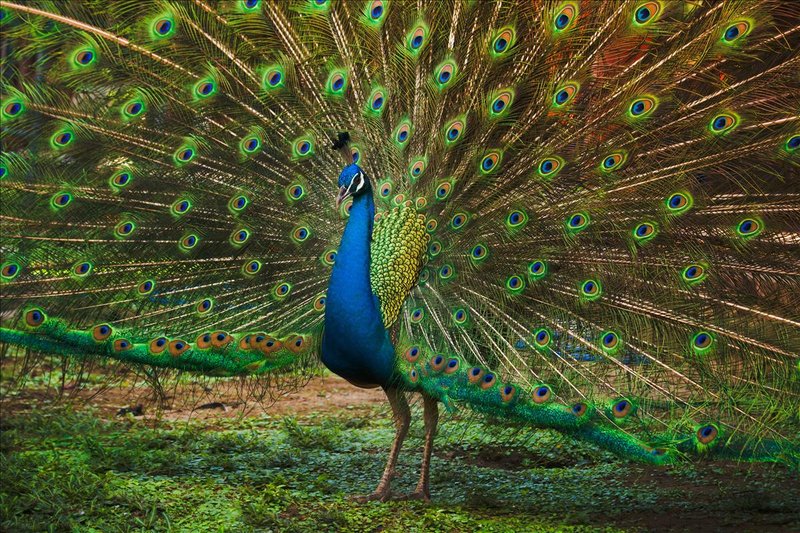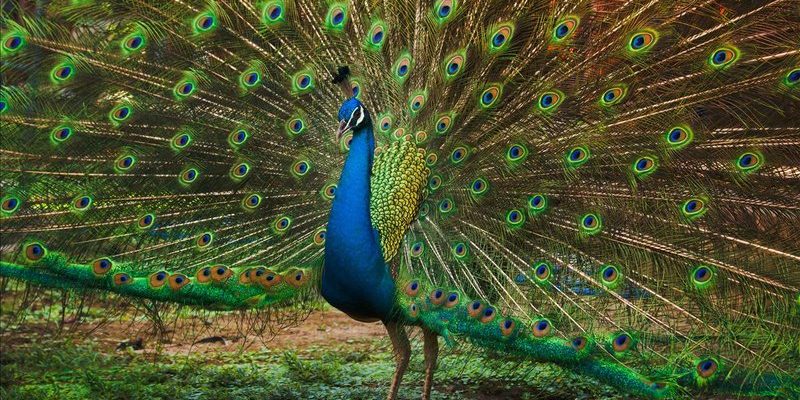
When you think of grace and beauty in the animal kingdom, the Indian Peafowl—commonly known as the peacock—likely struts into your mind. These magnificent birds are truly a sight to behold, with their iridescent feathers and elegant tail displays. Imagine walking through a serene garden, and suddenly, a peafowl spreads its vibrant tail like an artist unveiling a masterpiece. Not only do they captivate our eyes, but they also have a fascinating life filled with unique behaviors and traits.
The Indian Peafowl is not just a pretty face; it’s a creature rich in symbolism and cultural significance. As the national bird of India, it represents grace and beauty in various cultures. But there’s so much more to these birds than their stunning looks, from their mating rituals to their social structures. Let’s dive in and explore what makes the Indian Peafowl truly remarkable.
Physical Characteristics
First things first: let’s talk about their looks. The adult male Indian Peafowl is renowned for its stunning plumage. Each feather in its tail is like a tiny canvas, decorated with mesmerizing eye-like patterns called “ocelli.” When the peacock fans out its tail, it’s like watching a dazzling display of jewels sparkling in the sunlight. These feathers can reach up to 6 feet in length, making it one of the longest feathered tails in the bird world. And yes, female peafowls, or peahens, may not have the same flamboyant colors, but they are equally charming with their muted browns and greens. This coloration helps them stay hidden from predators, especially when nesting.
The size of an Indian Peafowl is another point of interest. Males can weigh between 8 to 13 pounds, while females are typically lighter, weighing around 5 to 9 pounds. But what truly steals the show is their height: adult peafowls can stand anywhere between 3 to 4 feet tall. Imagine them strutting through a lush landscape, their vibrant tails flowing behind. It’s no wonder they’ve captured the hearts of so many!
Interestingly, the peacock’s coloration comes from microscopic structures in the feathers, not pigments. This means they produce their vibrant colors through light refraction, giving them a shimmering effect. It’s a bit like how a prism creates rainbows from light, demonstrating just how intricate and beautiful nature can be.
Natural Habitat
The Indian Peafowl is native to the Indian subcontinent, thriving in a range of habitats. You’ll typically find them in forests, grasslands, and even in open fields. They love areas where they can forage for food while also having plenty of cover from predators. These birds are quite adaptable; they can also be spotted near agricultural fields and human settlements, where they often scavenge for food.
During the breeding season, Indian Peafowl can be quite vocal. You might hear their distinctive calls echoing through the countryside. They prefer habitats that provide ample vegetation, ensuring they can stay safe while still enjoying access to their favorite snacks. In many parts of India, they’ve become a common sight around temples and palaces, often seen wandering freely. Their presence adds a hint of wild beauty to these serene locations.
Climate plays a significant role in the peafowl’s habitat preferences. While they can tolerate some temperature variations, they generally thrive in warmer climates. This adaptability makes them a common bird in many regions of India, where they can enjoy the ample sunshine and light rainfall that supports their feeding habits.
Diet and Feeding Habits
The diet of the Indian Peafowl is quite diverse. These birds are omnivorous, meaning they enjoy a little bit of everything. In their natural habitat, their meals might include fruits, seeds, insects, small mammals, and even snakes. If you’ve ever watched them hunt, you might have noticed their keen eyesight and agility as they stalk their prey, hoping to catch a quick snack. Isn’t it fascinating how their vibrant feathers can conceal such stealthy hunters?
Peafowls are known for scratching the ground to uncover hidden food just like a chicken would. They often forage in groups, which not only boosts their chances of finding food but also provides safety in numbers. This social feeding behavior helps them stay alert to potential threats while they enjoy their meals. They are often seen hunting together, chattering and calling to one another as they discover delicious treats.
In captivity, their diet can be supplemented with grains, vegetables, and specially formulated bird pellets. However, if you’re ever lucky enough to observe them in the wild, you’ll likely see them indulging in a buffet of natural delicacies, showcasing their adaptability and foraging skills.
Mating and Breeding
Here’s where things get really interesting! The mating rituals of the Indian Peafowl are a grand spectacle. During the breeding season, male peacocks put on elaborate displays to attract females. They fan out their magnificent tail feathers, creating an impressive display that can be seen from afar. It’s a competition of beauty; the more vibrant and extensive the tail, the more attractive the peacock appears to potential mates.
Females carefully observe these displays, assessing the quality of the males. They tend to prefer males with larger tails that showcase more “eyes.” After some flashy courtship, a female will choose a mate, and the pair will go through some impressive rituals that may include bowing and even vocalizations. It’s like a delicate dance where both birds put their best foot forward—quite literally!
The peahen typically lays between 3 to 6 eggs at a time, and she will incubate them for about 28 days. Once the chicks hatch, they are precocial, meaning they can walk and feed themselves soon after birth. This early independence is crucial, as being a chick in the wild comes with its own set of challenges. Both parents are usually protective, guiding their young through their first few weeks of life and teaching them essential survival skills.
Conservation Status
Despite their beauty, the Indian Peafowl has faced threats from habitat loss and hunting. Their stunning feathers have made them targets in the illegal wildlife trade. Thankfully, efforts are being made to protect these gorgeous birds. They are listed as “Least Concern” on the IUCN Red List, thanks to their adaptable nature and wide distribution throughout India. They thrive in protected areas, such as national parks and wildlife reserves where they can roam freely.
Conservation programs focus on habitat preservation and community awareness. By working with local communities, conservationists aim to reduce human-wildlife conflict, ensuring that these majestic birds can thrive in their natural environment without fear. It’s essential for the future of the Indian Peafowl and the ecosystems they inhabit.
As a symbol of beauty in many cultures, the Indian Peafowl continues to remind us of the importance of preserving wildlife. By taking action to protect their habitats, we can ensure future generations get to experience the joy of witnessing these incredible birds in their natural surroundings.
Fun Facts About Indian Peafowl
- Indian Peafowl can fly short distances, usually just enough to reach a higher branch for safety.
- They are known to be quite vocal, making various sounds, including squawks and screams to communicate with each other.
- The peacock is a symbol of grace, beauty, and love in many cultures, often seen in art and literature.
- In addition to their vibrant colors, male peafowl can actually lose and regrow their tail feathers annually.
FAQs
What is the lifespan of an Indian Peafowl?
In the wild, Indian Peafowl can live around 15 to 20 years. However, those in captivity, where they face fewer threats and have regular access to food, can live even longer—sometimes up to 25 years or more!
Do Indian Peafowl migrate?
Indian Peafowl are generally non-migratory birds. They tend to stay within their home ranges, which provide sufficient food and shelter. However, seasonal changes in their habitat may cause them to move short distances in search of food and water.
Are Indian Peafowl social birds?
Yes! Indian Peafowl are social creatures and often found in small groups. They enjoy the company of their peers and can be seen foraging, roosting, and displaying together. Their social interactions add to their unique and captivating nature.
What do Indian Peafowl call sounds mean?
The variety of sounds made by Indian Peafowl serves different purposes. Their loud calls can signal alarm or attract mates. Each sound has its own context—sometimes they may be warning others of danger, while at other times, the calls are simply part of their daily communication.
Can Indian Peafowl be kept as pets?
While Indian Peafowl can be kept in larger, suitable environments, they are not commonly kept as household pets like cats or dogs. They require ample space to roam, and their social nature means they thrive better in groups rather than isolation.
How can we help conserve Indian Peafowl?
Conservation efforts can start at the individual level. Supporting local wildlife organizations, promoting awareness about these birds, and advocating for habitat protection are essential steps. Also, never purchase products made from peafowl feathers, as this contributes to illegal trade.
Are male and female Indian Peafowl equally colorful?
No, male Indian Peafowl are known for their spectacular plumage, displaying vibrant blues, greens, and iridescent patterns. In contrast, females, or peahens, are more subdued in color, featuring browns and greens that provide camouflage, especially during nesting.
How do Indian Peafowl display their feathers?
During courtship, male peafowl perform a beautiful display by fanning out their long tail feathers, creating a stunning fan-like shape. This display can be accompanied by dancing, shaking, and vocalizations to attract a female’s attention.
What is the mating season for Indian Peafowl?
The mating season for Indian Peafowl typically occurs during the spring and early summer months. This is when males showcase their dazzling feathers to attract females, engaging in elaborate displays and rituals to win their favor.
Do Indian Peafowl have natural predators?
Yes, Indian Peafowl have several natural predators, including large birds of prey, wild cats, and even dogs. Their keen eyesight and ability to fly short distances help them evade these threats, but they remain vigilant in their natural habitats.
Why are Indian Peafowl considered a symbol of beauty?
Indian Peafowl are admired for their striking appearance, particularly the male’s elaborate tail feathers. Throughout history, they have been featured in various cultures’ art, literature, and folklore, symbolizing grace, beauty, and love.
How do Indian Peafowl communicate?
Indian Peafowl communicate through a range of vocalizations, including calls and squawks. Vocal communication plays a significant role in alerting others to danger or signaling their presence and emotions within their social groups.

